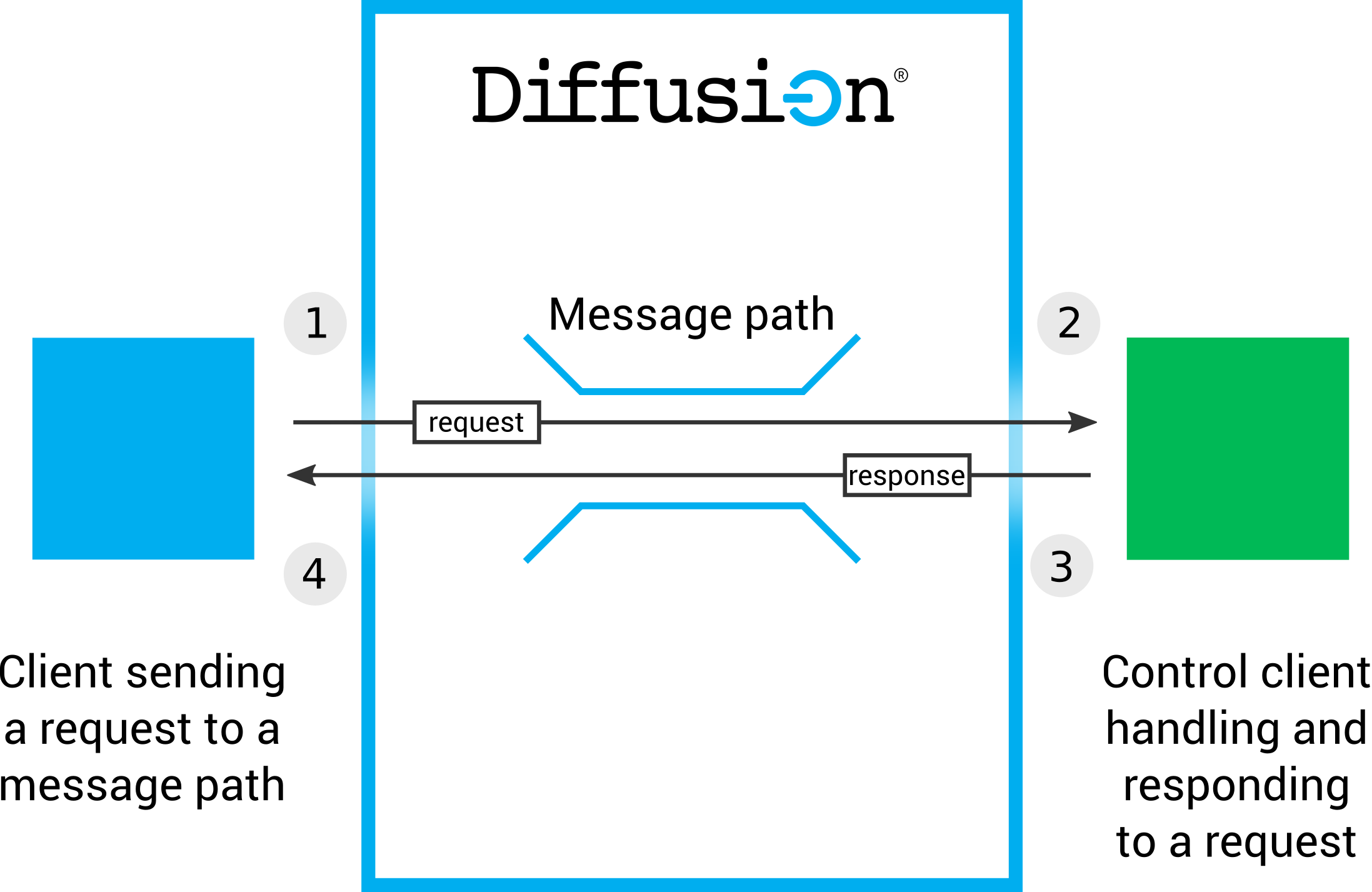Sending request messages to a message path
A client session can send a request message containing typed data to a message path. One or more client sessions can register to handle messages sent to that message path. The handling client session can then send a response message containing typed data. The response message is sent to the requesting client session directly, through the same message path.

- A client session sends a request message to a message path.
- The control client session receives the request message through a request handler.
- The session client session uses sends a response to the request message.
- The client session receives the response.
Both the request message and the response message contain typed values. The messages can contain data of one of the following types: JSON, binary, string, 64-bit integer, or double. The response message is not required to be the same data type as the request it responds to.
Sending to a message path
Required permissions: permission for the specified message path
- The message path to send the request to and receive the response through
- The request message
- The datatype of the request message
- The datatype of the response message
[session.messaging sendRequest:[PTDiffusionPrimitive requestWithLongLong:42]
toPath:message_path
int64NumberCompletionHandler:^(NSNumber *response, NSError *error)
{
if (error) {
NSLog(@"Failed to send to %@. Error: %@", message_path, error);
} else {
NSLog(@"Received response: %@", response);
}
}];
//Establish client sesssion
final Session session = Diffusion.sessions().principal("client").password("password").open("ws://localhost:8080");
//Obtain the Messaging feature
final Messaging messaging = session.feature(Messaging.class);
//Create a JSON object to send as a request
final JSON request = Diffusion.dataTypes().json().fromJsonString("\"hello\"");
//Send the request to a message path "foo" and wait for (at most) 5 seconds until the response is received.
final JSON response = messaging.sendRequest("foo", request, JSON.class, JSON.class).get(5, TimeUnit.SECONDS)
// Example with json topic type.
var jsonType = diffusion.datatypes.json();
// Create a JSON object to send as a request.
var requestJson = jsonType.from("hello");
// Send the request to a message path "foo".
session.messages.sendRequest('foo', requestJson, jsonType).then(function(response) {
console.log(response.get());
}, function(error) {});
Responding to request messages sent to a message path
Required permissions: permission for the specified message path, permission, and permission to register to receive session property values with the request message
Define a request handler to receive and respond to request messages that have a specific data type.
@interface NumberRequestDelegate : NSObject<PTDiffusionNumberRequestDelegate>
@end
@implementation NumberRequestDelegate
-(void)diffusionTopicTreeRegistration:(PTDiffusionTopicTreeRegistration *)registration
didReceiveRequestWithNumber:(nullable NSNumber *)number
context:(PTDiffusionRequestContext *)context
responder:(PTDiffusionResponder *)responder;
{
// Do something when a request is received.
}
- (void)diffusionTopicTreeRegistration:(nonnull PTDiffusionTopicTreeRegistration *)registration
didFailWithError:(nonnull NSError *)error
{
// Do something if the registration fails.
}
- (void)diffusionTopicTreeRegistrationDidClose:(nonnull PTDiffusionTopicTreeRegistration *)registration
{
// Do something if the registration closes.
}
private final class JSONRequestHandler implements MessagingControl.RequestHandler<JSON, JSON> {
@Override
public void onClose() {
....
}
@Override
public void onError(ErrorReason errorReason) {
....
}
@Override
public void onRequest(JSON request, RequestContext context, Responder<JSON> responder) {
....
responder.respond(response);
}
}
var jsonType = diffusion.datatypes.json();
var requestJson = jsonType.from({ "foo": "bar"});
var responseJson = jsonType.from({ "ying": "yang"});
// Define a request handler for json topic type
var handler = {
onRequest: function(request, context, responder) {
responder.respond(responseJson, jsonType);
},
onError: function() {},
onClose: function() {}
};
Register the request handler against a message path. You can only register one request handler against each message path.
// Ensure to maintain a strong reference to your delegate as it
// is referenced weakly by the Diffusion client library.
NumberRequestDelegate *const delegate = [NumberRequestDelegate new];
PTDiffusionRequestHandler *const handler = [PTDiffusionPrimitive int64RequestHandlerWithDelegate:delegate];
[session.messagingControl addRequestHandler:handler
forPath:path
completionHandler:^(PTDiffusionTopicTreeRegistration *registration, NSError *error)
{
// Check error is `nil`, indicating success.
}];
messagingControl.addRequestHandler(messagePath, JSON.class, JSON.class, new JSONRequestHandler());
var handler = {
onRequest: function(request, context, responder) {},
onError: function() {},
onClose: function() {}
};
session.messages.addRequestHandler('topic', handler);